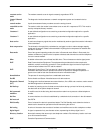
Glossary
Glossary-73910-A2-GN32-40 September 1998
A function available when in Dial Backup mode that allows the modem to switch to dial-line
operation when currently on leased lines.
A type of 6-position jack normally used with permissive dial networks and telephone sets.
A type of 50-position jack normally used with permissive dial networks providing the appropriate
conductors for up to eight telephone lines.
Shared Diagnostic Control Panel. A feature that allows carrier-mounted devices to share the
same diagnostic control panel. Installed into one COMSPHERE 3000 Series Carrier, it controls
and monitors the devices in all the carriers in the cabinet. A single SDCP can control up to
8 carriers, with a total of 128 devices.
Shared Diagnostic Unit. A circuit card installed in Slot 0 of the COMSPHERE 3000 Series
Carrier that provides an interface between an optional SDCP or network management system
and the devices in the carrier.
A data transmission channel with a lower signaling rate than the primary channel. It is mostly
used for modem diagnostics.
An SDCP key that allows the selection of a specific card slot in the COMSPHERE 3000 Series
Carrier.
A way of transmitting data in which bits are sent sequentially one at a time.
A bay in the carrier into which a circuit card can be installed.
Internal storage areas that contain information affecting the modem parameters.
Sub-Network Health and Status. A display of alarm occurrences in downstream modems.
A factory-preset configuration area containing configuration options most often used in
synchronous dial networks.
Transmission in which the data characters and bits are transmitted at a fixed rate with transmitter
and receiver synchronized. This eliminates the need for start and stop bits as used in
asynchronous transmission, and is thus faster and more efficient.
Time Division Multiplexer. A device that enables the simultaneous transmission of multiple
independent data streams into a single high-speed data stream by simultaneously sampling the
independent data streams and combining these samples to form the high-speed stream.
Trellis Multipoint. A proprietary high speed, fast poll multipoint modulation scheme.
The starting point of the menu tree that displays second-level menu branches.
A process where two modems try to establish a connection over the telephone (voice frequency)
line.
Advanced error correction coding technique for primary data typically used on higher speed
modems. This modulation scheme uses Forward Error Correction for multipoint and high-speed
point-to-point applications.
A unit that is under the control of another unit.
Underwriter’s Laboratories, Inc. An organization which promotes product safety.
A factory-preset configuration area containing the configuration options most often used in a
UNIX dial network.
A device connected logically closer to the host computer.
Universal Service Ordering Codes. Generic telephone company service ordering codes.
An ITU-T standard for modems operating full-duplex with asynchronous or synchronous data at
1200 bps over the dial network (PSTN).
Return to Dial
RJ11
RJ21
SDCP
SDU
secondary channel
Select key
serial transmission
slot
S-registers
SubHS
Sync Dial
synchronous
transmission
TDM
TMp
Top-Level menu
training
trellis-coded
modulation
tributary unit
UL
UNIX Dial
upstream modem
USOC
V.22


















